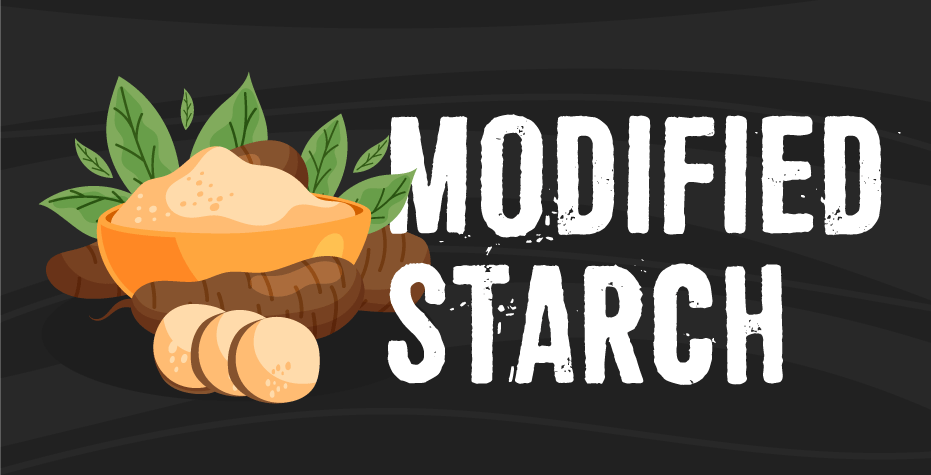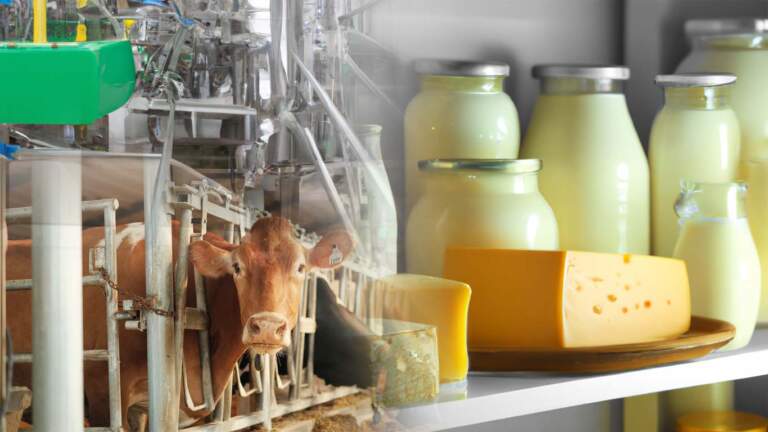Enjoying tasty mayonnaise in sandwiches or sipping thick vegetable soup, Most of the foodstuff contains ‘Modified starch’. However, This Modified starch present in food, provides different properties to food. But, we should know from where it comes to our food? What are the processing and, What are the uses of ‘Modified starch’ in foodstuff?
First, We can start from understanding about ‘Starch’…
What is Starch?
Starch is derived from plants, cereals (maize and wheat), and tubers (potatoes). Starch is carbohydrates presents in abundant amount in different parts of the plant, such as leaves, fruits, seeds, and different types of stems and roots. Plants produce energy from starch. And plants produce starches by chemical process involved in ‘Photosynthesis’.
Two types of polymers synthesize starch in plants i.e. Amylose and, Amylopectin. Amylose consists of a linear chain of α-1,4 glucans with limited branching points at the α-1,6 positions and constitutes between 15-30% of common starch. And, Amylopectin contains linear chains of glucose units linked by α-1,4 glycosidic bonds. And is highly branched at the α-1,6 positions by small glucose chains at intervals of 10 nm along the molecule’s axis.

What is Modified starch & Process of starch modification
All starch present are not in modified form and have very few uses in Food Industry. In general, native starches produce weak-body, cohesive, rubbery pastes when heated and undesirable gels when the pastes are cooled. And, That is why the food manufacturers prefer starches with better behavioral characteristic than those provided by native starches. So, Modified starch play there role in food. The properties of starches can be improved by various modifications.
The aim of this modification is to improve its properties, especially, In specific applications, such as improving water holding capacity, heat resistant behavior, strengthening its binding, minimizing starch syneresis, and enhancing thickening.
Methods of preparing ‘Modified starch’ in food
However, Different methods are developed to modify starch to make it more efficient and use for
various applications.
In fact, All modification techniques change the chemical and physical properties of the starch polymers. And, increase its value for the food industry and also for the non-food industry.
Modifications of starch include physical, chemical methods.
Physical Methods of starch Modification
1. Annealing
Annealing refers to the treatment of starch at temperatures below the starting temperature of gelatinization in excess water (<65 % w/w) or at intermediate water content (40–50 % w/w). The physical goal of annealing is to approach the temperature of the glass transition, which improves molecular mobility without causing gelatinization.
2. Retrogradation
The process of retrogradation known as the linking of starch chains into crystalline structures. Retrogradation is especially sensitive to the linear fraction of starch. High thermostability (dissolution in water at 120-150°C) and resistance to amylase activity characterize amylose crystals.
Amylopectin, however, is steadily retrograde as the branched starch fraction; whereas crystalline forms occurring only on the outside of the globule distinguished by a slightly lower re-pasting temperature (40-70°C) and an increased susceptibility to amylases activity than the retrograded amylose activity.
Starch recrystallization most easily happens at a temperature of approximately 0°C, but also at temperatures over 100°C, but it only refers to amylase then. It intensifies the retrogradation. Repeated freezing and defrosting of the starch paste by use. Consequently, the resulting starch generated as resistant starch.
3. Gelatinization
In both the chemical and physical composition of granular starch, the gelatinization process induces significant changes. Owing to the rearrangement of the bonding of intra- and intermolecular hydrogen between the molecules of water and starch, the molecular order within the starch granule collapses or disrupts.
This results in changes in the starch properties that are permanent. Irreversible granular swelling, loss of bifringence and crystallinity are evidence of the loss of an ordered structure.
Chemical Methods of starch Modification
In Chemical Modified starch processing, involves the introduction of functional groups into the starch molecule, resulting in significantly altered Physico-chemical properties.
1. Etherification & Esterification
This process mainly involves replacement by different hydrophobic functional groups of hydrophilic hydroxyl starch groups resulting in hyproxypropylation, carboxymethylation, acetylation, succinylation, etc.
The carboxymethyl substitution of starch hydroxyl groups gives rise to cold-water-soluble derivatives. The reaction has to perform in an organic medium to avoid starch gelatinization.
Hydrophobic acetyl groups replace Hydrophilic hydroxyl groups in acetylation. Acetylation makes starch more hydrophobic and prevents hydrogen bonding between hydroxyl groups and molecules of water from forming.
2. Cross-Linking
Cross-linking strengthens the bonds of hydrogen in the granule with chemical bonds that serve as a bridge between the molecules of the starch. Also, Chemical reagent structure, reagent concentration, pH, reaction time and temperature are essential factors in the cross-linking reaction.
Since the degree of cross-linking for food starch is very low, it is difficult to chemically calculate the extent of reaction and yield of cross-linking starch; therefore, physical property measurement is required.
3. Acid Treatment
Without destroying its granule structure, acid modification modifies the physicochemical properties of starch and, Similarly, the properties of acid-thinned starches vary according to their sources.
The hydroxonium ion attacks the glycosidic oxygen atom in acid alteration and hydrolyzes the glycosidic linkage. Until it eventually reaches the inner zone, an acid acts on the surface of the starch granule first.
4. Oxidation
By reacting starch with a given amount of oxidizing reagent. It gives Oxidized starch under regulated temperature and pH. Moreover, Oxidation induces depolymerization, which results in a lower viscosity of dispersion and introduces groups of carbonyl and carboxyl, which delay recrystallization.
Application of Modified starch in Food Industry
Starch/Modified starch in Bakery
Baked products such as Biscuits, cookies, pies, breads, and cakes are high-density products and require heat-sensitive starches. Hence, Modified starch (crosslinked starches) are used since they are more resistant to oven baking temperatures of 120 ≥ 230°C.
Starch/Modified starch in Confectionery
Oxidized starches have high clarity or transmittance, poor viscosity, and low stability of temperatures. Therefore, It is widely used for coating candies and sweets in confectioneries because they melt quickly.
Gravies, soups and sauces made with Starch/Modified
Food products like Sauces, soups, and gravies contain modified starch. Etherified and crosslinked starches are mostly used. Additionally, Starch crosslinked ones have, Higher granule stability-swelling, high-temperature tolerance, high shear stability, and stability under acidic conditions.
In Low-fat mayonnaise development, The use of modified starch as a water-soluble gelling agent to ensure the stability of high-shear emulsion in mayonnaise, especially in the case of low-fat salad dressings.
Starch & Modified starch in Pasta and Puddings
In pasta development, pregelatinized and cross-linked starches mostly used. As well as, Gelatinized starches influence the elasticity and smoothness of pasta, detectability, and digestibility. Crosslinking provides the pasta with the required structural firmness.
To achieve thickening or water preservation mixed with Pregelatinized starches without using heat in puddings, instant lactic mixtures, and breakfast foods.
Conclusion
In the final analysis, The significance of starch and modified starch as a biopolymer contributing to its versatility seems to be on the upward trend. Also, It has moved from its conventional use as a food source for energy to more advanced food and non-food applications.
In reality, modified starch(es) in food give tremendous functional advantages to a range of foods, including bakeries, sandwiches, drinks, and nutritious foods. As fat replacer/fat mimetic, as texture improver. Also, Use of Modified starch in food for high nutritional claim, high stability of shear and temperature. And, encapsulation of flavor/oil but for high nutritional claim, high stability of shear and temperature, However, even more advantages remain to be found.
References
- Abbas, K. & Khalil, Sahar & Meor Hussin, Anis Shobirin. (2010). Modified Starches and Their Usages in Selected Food Products: A Review Study. Journal of Agricultural Science. 2. 10.5539/jas.v2n2p90.
- Haq Nawaz, Rashem Waheed, Mubashir Nawaz, and Dure Shahwar (March 11th, 2020). Physical and Chemical Modifications in Starch Structure and Reactivity, Chemical Properties of Starch, Martins Emeje, IntechOpen, DOI: 10.5772/intechopen.88870.
- Henry Omoregie Egharevba (August 5th, 2019). Chemical Properties of Starch and Its Application in the Food Industry, Chemical Properties of Starch, Martins Emeje, IntechOpen, DOI: 10.5772/intechopen.87777.
- Krithika, P., & RATNAMALA, D.K. (2019). MODIFICATION OF STARCH: A REVIEW OF VARIOUS TECHNIQUES.







Leave a Comment